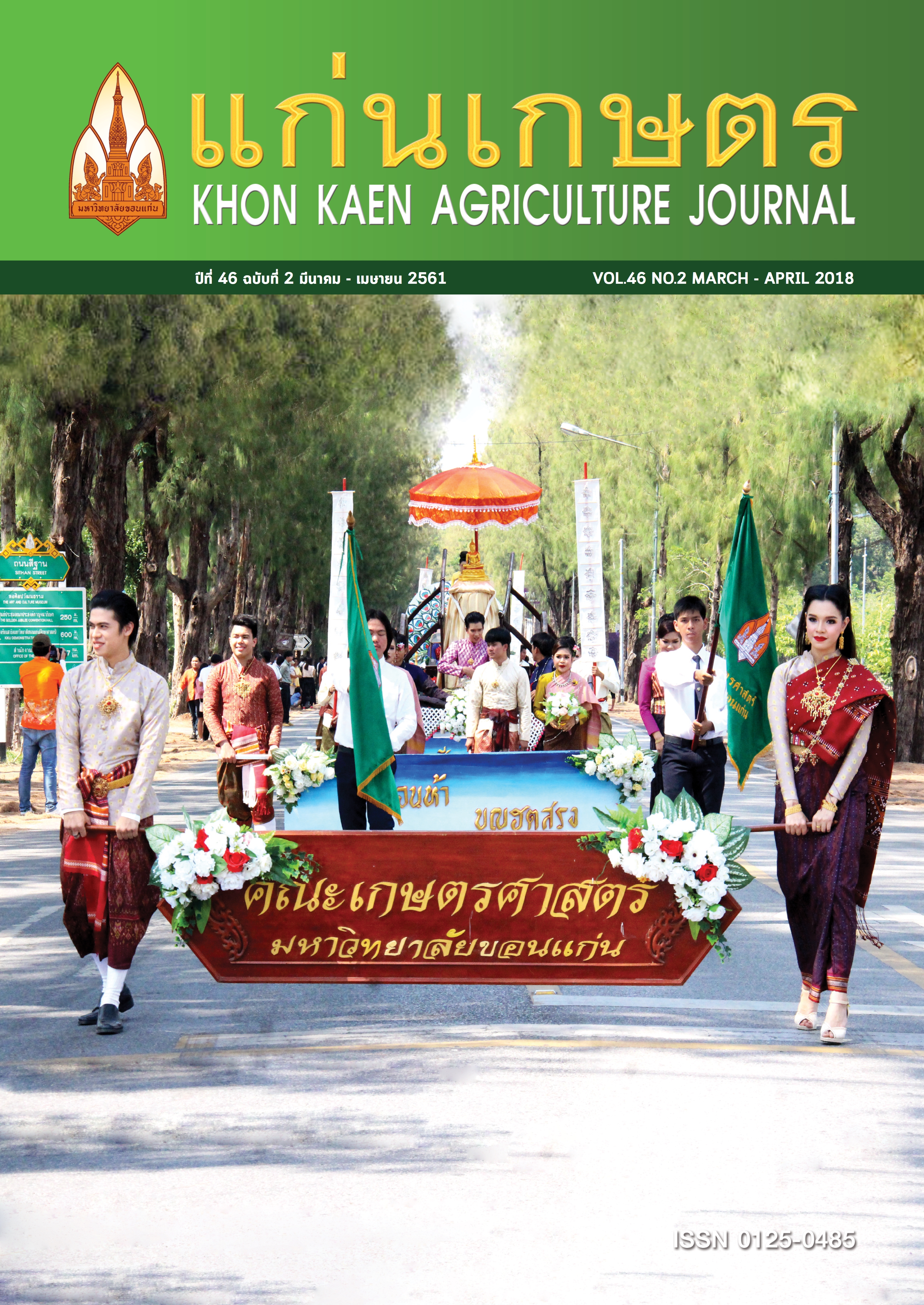ลักษณะการดูดซับโพแทสเซียมของดินที่ใช้ปลูกอ้อยในจังหวัดสระแก้ว
Main Article Content
บทคัดย่อ
การศึกษานี้มีวัตถุประสงค์เพื่อศึกษาลักษณะการดูดซับโพแทสเซียม และสมบัติของดินที่มีผลต่อการดูดซับโพแทสเซียมของดินที่ใช้ปลูกอ้อยในจังหวัดสระแก้ว โดยคัดเลือกตัวแทนชุดดินซึ่งมีสมบัติดินที่แตกต่างกันและใช้ปลูกอ้อยเป็นบริเวณกว้างขวาง จำนวน 4 ชุดดิน ได้แก่ ชุดดินวังไห (Wi) ชุดดินบางคล้า (Bka) ชุดดินเชียงคาน (Ch) และชุดดินทับพริก (Tpk) โดยเก็บตัวอย่างดินที่ระดับความลึกชั้นไถพรวน และใต้ฐานชั้นไถพรวนถึง 60 เซนติเมตร มาทำการศึกษา ผลการศึกษาพบว่า ดินที่ทำการศึกษาส่วนใหญ่มีปริมาณโพแทสเซียมที่เป็นประโยชน์ต่ำ และมีปริมาณโพแทสเซียมสำรอง (K reserve) จากแหล่งแร่ในดินอยู่น้อย ลักษณะการดูดซับโพแทสเซียมของดินที่ทำการศึกษาสามารถอธิบายได้ดีด้วยไอโซเทอมการดูดซับของ Freundlich (R2 = 0.755–0.997) แสดงว่า ดินมีลักษณะการดูดซับโพแทสเซียมบนผิวหน้าที่ไม่สม่ำเสมอ ซึ่งอาจเป็นการดูดซับบนพื้นผิวของแร่ดินเหนียวหลายชนิดร่วมกับอินทรียวัตถุ โดยสมบัติของดิน ได้แก่ ปริมาณอนุภาคขนาดดินเหนียว และค่าความจุแลกเปลี่ยนแคตไอออน มีสหสัมพันธ์เชิงบวกกับปริมาณโพแทสเซียมที่แลกเปลี่ยนได้ และความจุในการดูดซับโพแทสเซียมของดิน
Article Details
เอกสารอ้างอิง
สำนักงานคณะกรรมการอ้อยและน้ำตาลทราย. 2559. รายงานพื้นที่ปลูกอ้อยปีการผลิต 2558/2559. สำนักงานคณะกรรมการอ้อยและน้ำตาลทราย กระทรวงอุตสาหกรรม, กรุงเทพฯ.
เสาวนุช ถาวรพฤกษ์, ณัฐพล จิตมาตย์, เพชรดา ปินใจ, ทิมทอง ดรุณสนธยา และ รฐนนท์ เจริญชาศรี. 2558. การจัดชั้นสมรรถนะความอุดมสมบูรณ์และศักย์ผลิตภาพของดินที่ใช้ปลูกอ้อยในภาคตะวันออกของประเทศไทย. รายงานวิจัยฉบับสมบูรณ์. โครงการการพัฒนาดัชนีคุณภาพและผลิตภาพของดินเพื่อการผลิตอ้อยในภาคตะวันออกของประเทศไทย. ภาควิชาปฐพีวิทยา คณะเกษตร มหาวิทยาลัยเกษตรศาสตร์.
Ali, W., M. Hussain, M. Ali, M. Mubushar, M. A. R. Tabassam, M. Mohsin, and H. A. A. Nasir. 2013. Evaluation of Freundlich and Langmuir isotherm for potassium adsorption phenomena. Intl. J. Agri. Crop Sci. 6: 1048-1054.
Bangroo, S. A., M. A. Wani, T. Ali, M. A. Malik, N. A. Kirmani, J. A. Sofi, and F. U. Rasool. 2012. Potassium adsorption characteristics of soils under long term maize-legume cropping sequence. Afr. J. Agric. Res. 7: 6502-6507.
Bray, R. H., and L. T. Kurtz. 1945. Determination of total, organic, and available forms of phosphorus in soils. Soil Sci. 59: 39–46.
Darunsontaya, T., A. Suddhiprakarn, I. Kheoruenromne, and R. J. Gilkes. 2010. The kinetics of potassium release to sodium tetraphenylboron solution from the clay fraction of highly weathered soils. Appl. Clay Sci. 50: 376–385.
Gee, G.W., and J. W. Bauder. 1986. Particle-size analysis. pp. 383-411. In: A. Klute. Methods of Soil Analysis: Part 1–Physical and Mineralogical Methods. Am. Soc. Agron. Inc., Madison, WI. Hafiz, N., S.M. Adity, S. F. Mitu, and A. Rahman. 2016. Effect of manure types on phosphorus sorption characteristics of an agricultural soil in Bangladesh. Cogent Food Agri. 2: 1-13.
Hannan, A., A. M. Ranjha, M. Waqas, and A. Niaz. 2007. Potassium adsorption characteristics of four different textured alkaline calcareous soils. Pak. J. Agri. Sci. 44: 242-247.
Havlin, J. L., J. D. Beaton, S. L. Tisdale, and W. L. Nelson. 2005. Soil Fertility and Fertilizers: An Introduction to Nutrient Management 7th Edition. Upper Saddle River, New Jersey.
Nelson, D. W., and L. E. Sommers. 1996. Total carbon, organic carbon, and organic matter. pp. 539–579. In: A. L. Page, R. H. Miller, and D. R. Keeney. Methods of Soil Analysis: Part 2–Chemical and Microbiological Properties. Am. Soc. Agron. Inc., Madison, WI.
Ngwe, K., I. Kheoruenromne, and A. Suddhiprakarn. 2012. Potassium status and physicochemical and mineralogical properties of lowland Vertisols in a rice-based cropping system under tropical savanna climate. Kasetsart J. Nat. Sci. 46: 522-537.
Pal, Y., R. J. Gilkes, and M. T. F. Wong. 1999. The forms of potassium and potassium adsorption in some virgin soils from south-western Australia. Soil Res. 37: 695-710.
Pratt, P. F. 1965. Potassium. pp.1023–1031. In: C.A. Black. Methods of Soil Analysis: Part 2–Chemical and Microbiological Properties. Am. Soc. Agron. Inc., Madison, WI.
Rao, C. S., A. S. Rao, K. V. Rao, B. Venkateswarlu, and A. K. Singh. 2010. Categorisation of districts based on nonexchangeable potassium: implications in efficient K fertility management in Indian agriculture. Indian J. Fert. 6: 40-54.
Sharma, R. K., M. Agrawal, and F. Marshall. 2006. Heavy metal contamination in vegetables grown in wastewater irrigated areas of Varanasi, India. Bull. Environ. Contam. Toxicol. 77: 312– 318.
Sharpley, A. N., and E. J. Kampath. 1988. Relationship between water soluble and exchangeable soil cations for estimating plant uptake and leaching potential. Commun. Soil. Sci. Plant Anal. 19: 739-753.
Singh, A. P., S. C. Mehta, and S. B. Mittal. 1988.Potassium adsorption in some potassium depleted soils. J. Indian Soc. Soil Sci. 35: 375-382.
Sparks, D. L. 2003. Environmental soil chemistry. 2nd Edition. Academic Press, San Diego.
Thomas, G. W. 1982. Exchangeable cations. pp. 159-165. In: C. A. Black. Methods of Soil Analysis: Part 2–Chemical and Microbiological Properties. Am. Soc. Agron. Inc., Madison, WI.
Wang, F. L., and P. M. Huang. 2001. Effects of organic matter on the rate of potassium adsorption by soils. Can. J. Soil Sci. 81: 325-330.
Whittig, L. D. 1965. X-ray diffraction technique for minerals identification and mineralogical composition. pp. 671-698. In: C.A. Black. Methods of Soil Analysis: Part 2–Chemical and Microbiological Properties. Am. Soc. Agron. Inc., Madison, WI.


